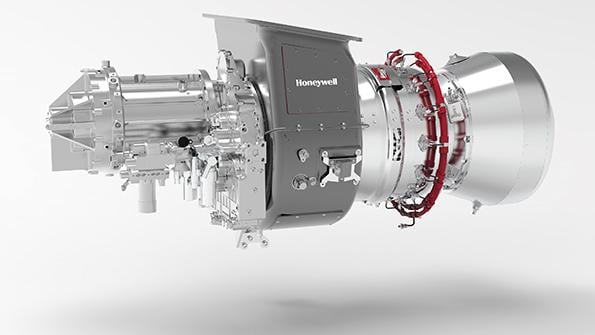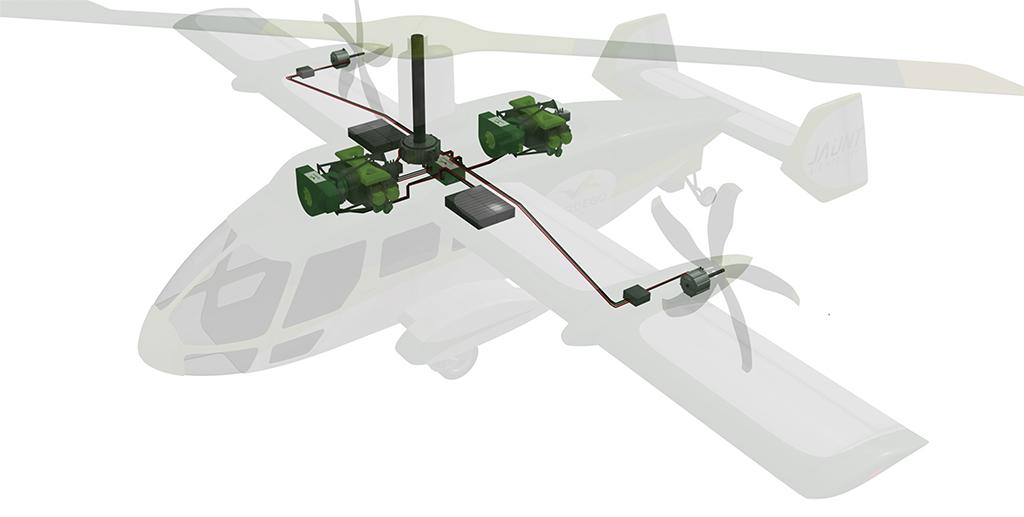Propulsion Providers Hop On Accelerating Hybrid Power Train

As interest grows in larger and more capable electric aircraft beyond the reach of current battery technology, power providers are stepping up development of hybrid systems that harness the core energy of turbine and piston engines.
Gas turbine-makers, including Honeywell and Safran, were among the first to reveal ambitions in the emerging hybrid sector, while General Electric and Rolls-Royce are also actively engaged. Pratt & Whitney, which was studying a PW100-size hybrid under its recently slowed Project 804 initiative, provides the PT6 turboprop at the core of the TBM 850-based EcoPulse, a distributed-propulsion hybrid dem-onstrator in development by Safran, Daher and Airbus.
- Honeywell developing APU-based turbogenerator
- Rolls and GE focus on new small turbine offerings
- VerdeGo unveils diesel-based hybrid system plan
But as the traditional engine-makers search for the sweet spot between conventional powerplants and batteries, at least one newcomer sees the opportunity to fill an emerging power gap for smaller cargo and air mobility applications. Hybrid-electric startup VerdeGo is stepping up to the established industry role of propulsion system supplier by revealing plans to certify and produce a 185-kW (248-hp) diesel-based hybrid system for a wide range of vertical-, short- and conventional-takeoff-and-landing aircraft.
Yet even for the seasoned turbine-makers this fledgling market is proving difficult to predict. Safran, for example, scored early positions on two turbogenerator projects only to see one of them, Zunum Aero’s hybrid-electric ZA10 regional aircraft, suffer financial collapse within weeks of being selected as the powerplant provider in late 2018. Safran’s second high-profile win as provider of hybrid-electric power for the Bell Nexus electric vertical-takeoff-and-landing (eVTOL) vehicle also ended in disappointment in early 2020 when Bell later opted to go all-electric.
As an indicator of how quickly this new power sector continues to evolve, Honeywell is already shifting gears to focus first on a higher-power, 1-megawatt turbogenerator based on the company’s HGT1700 auxiliary power unit (APU)—rather than prioritize testing of a 400-500-kW system first announced in 2019. The move to the larger turbogenerator, which is based on the APU developed for the Airbus A350 airliner, reflects what Honeywell sees as a shifting market trend toward more demanding power needs for electric aviation, particularly for nearer-term cargo applications.
This was underscored after a muted initial response to the smaller system, which was based on the HTS900 turbo-shaft, and a strategic shift by Honeywell to boost additional efforts in all-electric battery-powered propulsion. This culminated in a collaboration deal in mid-2019 with Japan-based electric car specialist Denso focused on all-electric and hybrid power concepts.
Since then, the hybrid-electric market has begun to surge with a variety of cargo and passenger vehicle projects for missions requiring greater payloads and longer ranges. A range of startups is working on the first hybrid-electric types including UK-based Faradair Aerospace, with which Honeywell signed a memorandum of understanding in December to collaborate on systems and a turbogenerator unit.

What is more, despite the refocus on the HGT1700, the company is also seeing renewed interest in the HTS900 turbogenerator. “We completed design work and mating of the HTS900 to two 200-kW generators, though we have not started testing,” says Taylor Alberstadt, Honeywell’s senior director of power systems business development. “We are in dialog with several potential customers for this system and would begin full-scale development and testing aligned with the needs of those programs.”
Alberstadt says there is “significant” interest in the smaller system. “Based on the discussions we’re having with customers and their specific requirements, it’s likely we’ll progress this activity going forward,” he says. Early test work on the HTS900 system has benefited development of the larger HGT1700 unit, which will begin demonstration tests in the third quarter. “Specifically, lessons were learned in software controls development and integration of an engine and generator,” he adds.
The HGT1700 system is 2.5 times more powerful than the HTS900-based unit. The larger generator—which weighs 280 lb.—will leverage lessons learned during the design and test of a 1-megawatt generator Honeywell developed for DARPA’s XV-24A LightningStrike vertical-takeoff-and-landing (VTOL) hybrid-electric X-plane.
Although the Aurora Flight Sciences-developed XV-24A was canceled in 2018, Honeywell continued work on the generator, which formed the design basis of the 200-kW unit unveiled with the HTS900 the following year. Designed to achieve an efficiency of 98%, compared with 92% for traditional aircraft generators, the unit was packaged with five times the power density of existing megawatt-class generators to enable the high levels of power required for electric propulsion.
Rolls-Royce, which was adapting an AE1107C turboshaft to power the XV-24A, also continues to eye the hybrid-electric sector with turbogenerator systems based on the M250 turboshaft and AE2100 turboprop. The M250 is aimed at vehicles requiring 500 kW to 1 megawatt of power, while the AE2100 formed the heart of a 2.5-megawatt system targeted at larger regional aircraft. A version developed for flight tests on the now-canceled Airbus E-Fan X hybrid propulsion demonstrator continues to be evaluated in ground tests.
Following initial ground tests in March 2019 of the M250 hybrid system at Rolls’ power rig facility in Indianapolis, the company has focused on integrating the power pack into its own tiltwing eVTOL design as well as supporting the APUS i-5—a zero-emissions flight demonstrator funded by the Berlin/Brandenburg regional government in Germany.
Under development by German aviation engineering services specialist APUS Group, the twin-boom i-5 will be configured with four propellers driven by a 700-kW, M250-based hybrid-electric system designed to work with batteries or hydrogen fuel cells. Initial flight tests will evaluate the performance of the high-voltage distributed-propulsion system before a second test phase in which the M250 will be replaced by a hydrogen fuel cell. From a long-term sustainable aviation perspective, “hybrid-electric propulsion makes sense only when you use renewable energy, and nothing is greener than hydrogen so far for such long-endurance missions,” says APUS founder Phillip Scheffel.
Rolls-Royce also continues other hybrid-electric-related ventures beyond turbogenerators, most recently joining a consortium led by U.S. startup Ampaire to demonstrate hybrid-electric aircraft on commuter routes in South West England. Under the 2Zero project (for Towards Zero Emissions in Regional Aircraft Operations), Rolls-Royce will supply an electric propulsion unit with certifiable safety features and high power-density, as well as a swappable battery system.
GE Aviation also is exploring the lower end of the hybrid-electric power spectrum with potential derivatives of its new 1,300-shp Catalyst turboprop—shortly to enter flight tests in Germany. These studies will build on earlier electrical power testing which, in late 2016, included modifying an F110-129 combat engine to extract up to 1 megawatt of power from the low- and high-pressure spools. The demonstration, supported by the U.S. Air Force Research Laboratory and NASA, extracted 250 kW from the high-pressure turbine and 750 kW from the low-pressure turbine.

In collaboration with the parent company’s Global Research Center, GE also developed and tested a 1-megawatt electric motor/generator in 2017. The high power-density device was tested at the company’s $51 million Electrical Power Integrated Systems Center—or EPISCenter—in Dayton, Ohio, followed by additional evaluation at the Peebles, Ohio, test site, where it was used to drive an 11-ft.-dia. Dowty propeller from a CT7 turboprop.
“Hybrid is interesting to us. You take the propeller off the Catalyst and put on a permanent magnet generator, and you have got a 1-megawatt solution,” says Paul Corkery, GE Aviation general manager of turboprops. “It fits very nicely in this class of aircraft because it is FADEC-equipped [full-authority digital engine control], which enables you to distribute the power and manage the engine as well. It’s also the performance—and the low fuel burn helps. This is in its infancy, but it’s going to ramp up exponentially, and technology-wise we feel we’ve got a pretty good solution to work with different people.” Target markets include cargo UAVs and training aircraft.
Further down the power range, VerdeGo Aero is also targeting a wide range of vertical-, short- and conventional-takeoff-and-landing aircraft with its first 185-kW VH-3-185 propulsion system. Cooperation agreements already signed with aircraft developers Airflow, Jaunt Air Mobility and XTI Aircraft involve single or dual installations of the VH-3-185, says VerdeGo CEO Eric Bartsch.
“We have built two generations of full-scale hardware and tested them to [technology readiness level] 6. The VH-3 is an evolution,” he says. “We have learned a lot about how to increase power and reduce weight and size. We have learned a lot from our customers, so we are moving into development of our first conforming article.”
VerdeGo is aiming for FAA certification of the VH-3-185 under Part 33 as a stand-alone propulsion unit, in the same way that conventional piston and turbine aircraft engines are approved. This will make the hybrid power unit applicable to different aircraft markets, manned and unmanned.
The core hybrid unit is a tightly integrated powerplant including an internal-combustion engine, motor/generator, power electronics and cooling systems. The unit is built around the SR305 certified diesel aeroengine from Safran company SMA. This runs on jet fuel or biofuel alternative.
Describing the third-generation VH-3 as “the Swiss Army knife” of hybrid systems, Bartsch says the unit can operate as a series or parallel hybrid or in other modes, depending on what the aircraft developer wants. “It can deliver electricity or drive a shaft, which provides flexibility in the downstream, customer-side, of the propulsion system,” he says.
In the series hybrid architecture, the diesel engine drives the generator to deliver 185 kW of electrical power to an array of distributed-propulsion motors or to battery packs. The unit can also drive a propeller or rotor with 185 kW of mechanical shaft power from the engine, bypassing the electrical system, or 185 kW of pure electrical power with the motor/generator running off batteries.
Alternatively, the unit can drive a prop or rotor with less than 185 kW while sending the balance of power from the diesel engine to battery packs or a distributed array of electric propulsors. The unit can also run in a parallel hybrid burst-power mode, combining the output of the diesel engine and battery-powered motor/generator to deliver 370 kW of shaft power.
VerdeGo has mapped four paths to market, ranging from experimental aircraft that do not require certification all the way to Part 33 type certification. The startup aims to begin low-volume deliveries within 18 months to two years, which will be before it achieves full Part 33 approval, Bartsch says.
VerdeGo is focusing on new aircraft configurations not possible without electric propulsion because of mechanical complexity, such as distributed-rotor vertical takeoff and landing and powered-lift short takeoff and landing. The company also sees application in thin-haul air transportation, where small turbine engines are now used for reliability but have high fuel burn. “With batteries and generators, we can get the same reliability with 40% less fuel burn,” says Pat Anderson, VerdeGo chief technology officer.
“Hybrid is how to get to electric aircraft and make them usable,” Bartsch says. Hybrid enables the design of electric aircraft with capabilities that will not be available for 20 years with batteries, he says, while enabling compatibility with existing Part 91 and Part 135 energy reserve requirements for safety.
Targeting the Part 23 aircraft market, VerdeGo initially looked at turbine-based hybrid propulsion but moved to a diesel-based architecture for lower cost, emissions and noise. “Turbine hybrid is not compatible with these aircraft,” Bartsch maintains.
While batteries continue to improve, Bartsch sees a long-term need for hybrid propulsion, noting that hybrid cars are still selling more than two decades after they were introduced. “In aerospace, we are back in 1995 in terms of the gap between battery technology and what is needed. We see a bright future for the next 20 years and beyond for hybrid.”





Comments